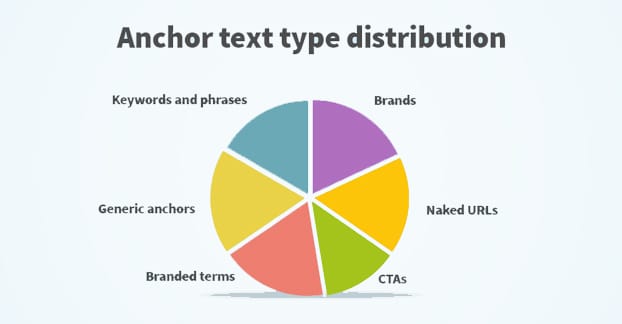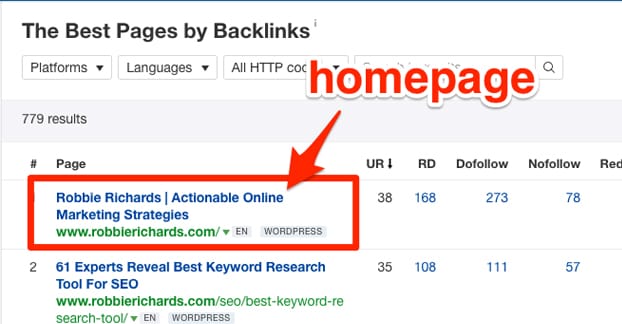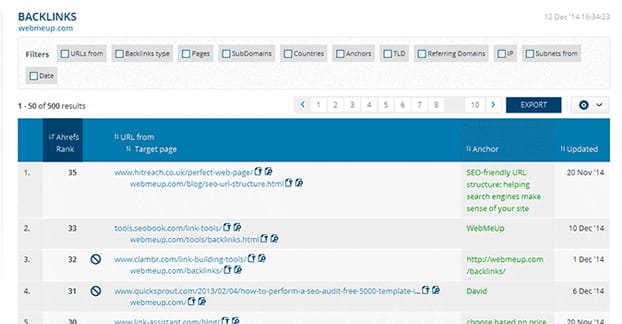If you’re not an absolute newcomer to the world of SEO, you know how important anchor text is. If you’re a newcomer and don’t understand why it’s as important as it is, you need a bit of a history lesson.
Anchor text was long used as a kind of indication of the content at the other end of a link. Initially this was fine; people would use anything from keywords to product names to article titles as anchor text, and it worked fine.
Then people realized that a keyword with a link was weightier than a different phrase, when linking to a keyword-optimized piece of content. Thus began an era where if your links didn’t use exact match keywords, you were wasting potential SEO value.
Then 2012 rolled around and Penguin hit.

Penguin was like Google’s previous major shakeup algorithm change, Panda. Only, instead of focusing on content quality, it focused on link quality. One thing Google discovered was that, when taking a link profile as a whole, the more “optimized” it was, the less valuable the site at the other end tended to be.
This primarily tended to hurt sites using artificial link building techniques. Private blog networks and spammy guest posts were primarily targeted. A shady webmaster would spin up 1,000 blog posts, include one link to their site with an exact match keyword in all of them, then submit them to directories, spam blogs, PBNs, and guest post hosts. The resulting link spam boosted their site, prior to Penguin. After penguin, it was a giant red flag that allowed Google to penalize those sites for abusing link schemes.
How does this affect links and anchor text in 2018 and beyond? Well, it means one thing: your link profile needs to be diverse. You need links from a variety of different sources, from a variety of different quality levels (as long as they aren’t spam), from a variety of different types of anchor text. If any one aspect of any of these sticks out too much as overly optimized, you’re going to run into potential penalties.
The Types of Anchor Text
There are a handful of different “types” of anchor text. Each type of text needs to be represented in your link profile. So, tip #1 for guest posting is: do not overly use any one type of anchor text.
Here are those types:
- Branded text. “Visit <BrandName> for more information.” These are important to have as part of your backlink profile, but are hard to get in the text of guest posts, because they tend to come across as very promotional.
- Generic text. “To find out more, <click here>.” These are going to show up one way or another, and shouldn’t be used in guest posts because they’re boring and don’t encourage the user to click.
- Naked text links. “You can read more at <www.example.com>.” These look unprofessional and, while they are used occasionally, are often better left alone.
- Hidden links. “Did you know bananas were <> almost inedible originally?” The link exists but has no anchor text; search engines see it, but users do not. This is often considered cloaking or a spam technique and will get both your site and the guest post site penalized. Don’t do it.
- Image anchors. Not technically text, but if you include an image, clicking on the image leads to your page. These are rare for guest posts simply because the hosting site will want to provide their own images, not use your submissions.
- Keyword anchors. “If you want to read more, read our <link building guide>.” Keyword anchors are fine to use! It’s only when you use the same keyword every single time you publish a guest post that you run into optimization problems.
- Semantic anchors. “So <how do you build backlinks>?” Semantic anchors are simply long-tail keywords made up of human speech, as would be searched using something like Alexa or Siri. Think of them like keyword anchors with a little more variety.
- Compound anchors. “You can read the <BrandName Guide to Link Building here>.” These are anchors made up of more than one of the above. This is an ideal way to vary up your link anchors; mix and match other anchor types into something more unique.
- Contextual fragments. “Did you know <bananas were almost inedible> originally?” These are similar to semantic anchors, but are less query-focused. Rather, they emphasis relevance to the content the user is reading.
Anchor text is important to pay attention to, and it’s crucial that you avoid overly optimizing your anchors from guest posts. You can’t necessarily control your anchors from links you don’t post, which means you need to do as much as you can for those you DO post.
The Purpose of The Link
In order to determine the kind of anchor text you should use, you need to determine the purpose or goal of the link. When writing a guest post, your goal is going to be fairly simple. In fact, there are only two real goals you can have: a link to a landing page to generate traffic and interest, or a link to a blog post to give a user further reading.
You almost never want a link directly to your homepage. If a homepage link is all you can get, like when the guest post host is letting you include one link to your brand in your author bio, then that’s what you get. That’s fine, but it means you should avoid direct links to your homepage wherever possible. You’re going to get them, usually branded anchors, so don’t over-do it.
For links that lead to a product page, landing page, or other conversion-focused page, you want more action-oriented anchor text. Generic anchor text can work if and only if the surrounding content is a relevant call to action. Even still, I prefer to compound a generic link with a brand or keyword. Compare these:
- If you would like to read more about link building, <just click>.
- If you would like to <read more about link building>, just click.
The first is a simple generic anchor and works, but is boring. The second has a keyword included, and is more of a keyword-focused call to action.
For links where you want to give the user further reading, there are a couple of different approaches.
The first approach is to simply use the title, or a shortened variation of the title, as the link anchor text. For example, linking to this post, I might use something like this: “Here’s a post you can read about choosing <which anchor text you should use>.” I could also just use the full title, something like “If you’re interested, I wrote a post titled < What Anchor Text Should You Use in Your Guest Post> that you can check out.
The second approach is to use the sentence fragment option. I often use this when I’m writing and referencing someone else’s post. For example, if I want to cite statistics by Quantcast, I could do something like this: “According to <statistics from Quantcast>, such and such a thing happens most often.”
The sentence fragment approach, for citing sources, tends to point to a third party. In my example, it would link to the specific Quantcast study I’m referencing. I could also do “<According to statistics> from Quantcast, such and such a thing.” In this case, I would likely link to my own coverage of the topic, which itself has a link to the relevant data. The source would be cited both ways, just slightly removed in the second option.
A Third Party Look
Gotch SEO has written a guide about anchor text. (See that one? Sentence fragment method. If I extended it to encompass the following three words, it would be a compound link anchor with a sentence fragment and a keyword.)
In his guide, Gotch recommends the following percentages:
- 70% branded anchor text.
- 20% naked links.
- 5% generic anchors.
- 1-5% each the remaining anchor types, including semantic and keyword-rich anchors.
- Less than 1% exact match keywords.
What do you think about his percentages? It’s worth noting that his involve all types of link building, not just guest posting.
The way I see it, Gotch is mostly accurate, but skewed in favor of heavy branding. Personally, I feel like it’s a better idea to include a brand as a compound anchor, if you include the brand at all, at least for guest posting.
Guest post hosts often don’t like overly promotional links. Even if the content is informational rather than promotional, including a brand name in your anchor text makes many people perceive it as more promotional than it is. This will often get the link changed or removed, so it’s better to avoid it.
Personally, I also don’t like naked links. I understand that sometimes people use them, and it’s a good way to use transparency to avoid URL parameters and redirects through third parties, but it’s often just unprofessional looking. Guest post hosts rarely want to use naked links, and I don’t blame them.
Generic anchors are fine in moderation, but if your entire backlink profile is generic anchors, you’ll end up with no clear focus or branding. Google prefers your anchors have some kind of aggregate value or indication of what lies at the other end. 10,000 “click here” links aren’t going to provide that.
My Recommendations
As far as guest posting goes, I would recommend using semantic, compound, and other partial or referential anchors.
The way I see it, a link should be a natural part of the text the user is reading. It should be part of, but not all of, a sentence that explains what the content is. The “written a guide” link above is one example. You know automatically from reading the sentence that it’s a guide about anchor text that was written by Gotch SEO, and that you can click it to read what he has to say and what I’m referencing when I talk about it. That’s plenty of purpose and value to a single link anchor.
I also figure that, as time goes on, semantic-style “keywords” are going to become more and more important. More and more people are using voice search with their phones, or using connected devices like the Amazon Echo or Google Home to relay information. That means an increasing segment of queries will come in semantic form, and targeting those more explicitly will help your SEO over time.
One area where I agree with Gotch is that you should use as few exact match keywords as possible. Exact match keywords – with exact match domains and keyword spam levels of density in the destination – are what caused Penguin to happen in the first place. You should keep those to as low a percentage as possible, or even forsake using them altogether. Google is smart enough to know the primary topic of your site without you needing to make it explicit every link you post. Plus, they just look spammy and are often jarring to read.
Above all, though, my number one tip is to simply vary the anchors you’re using. Try to always create a unique anchor for each guest post you write; it will be a relatively small portion of your overall backlink profile, while avoiding any over-optimization penalties.
To Sum Up
To put all of the above advice into a simple summary, here are your key points:
- Anchor text needs to be varied from post to post; avoid using the same phrases or keywords over and over.
- Avoid overly generic anchor text.
- Avoid “naked” links.
- Avoid hidden or cloaked links.
- Above all, make your anchor text relevant to both the hosting content and the destination content.
If you can cover all of those bases with your anchor text, you should be well off in terms of your link profile and your link safety.
 ContentPowered.com
ContentPowered.com








